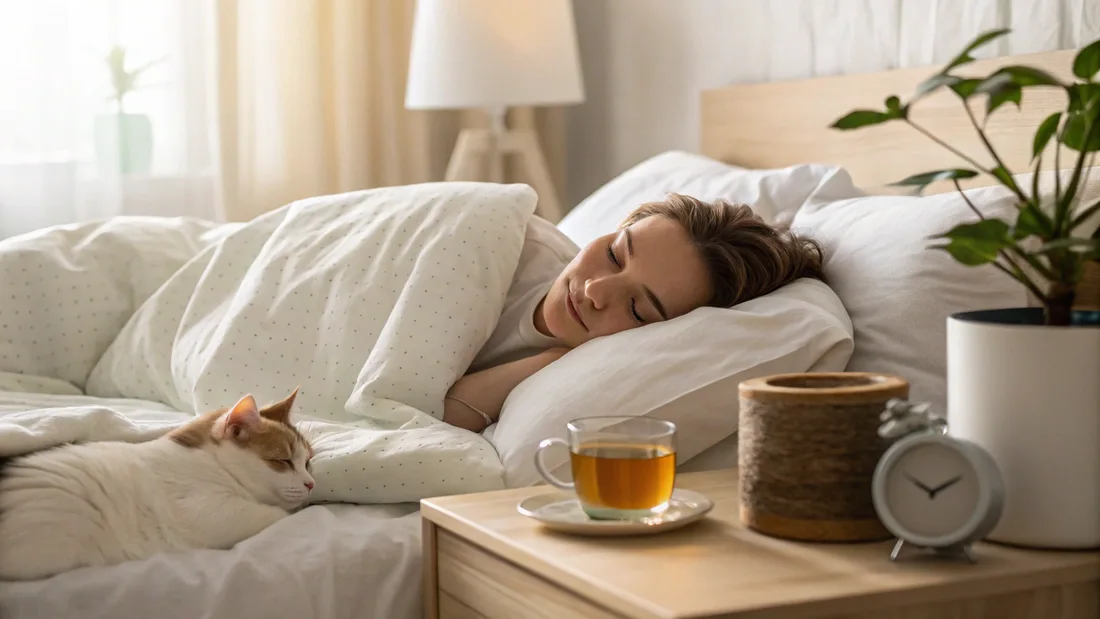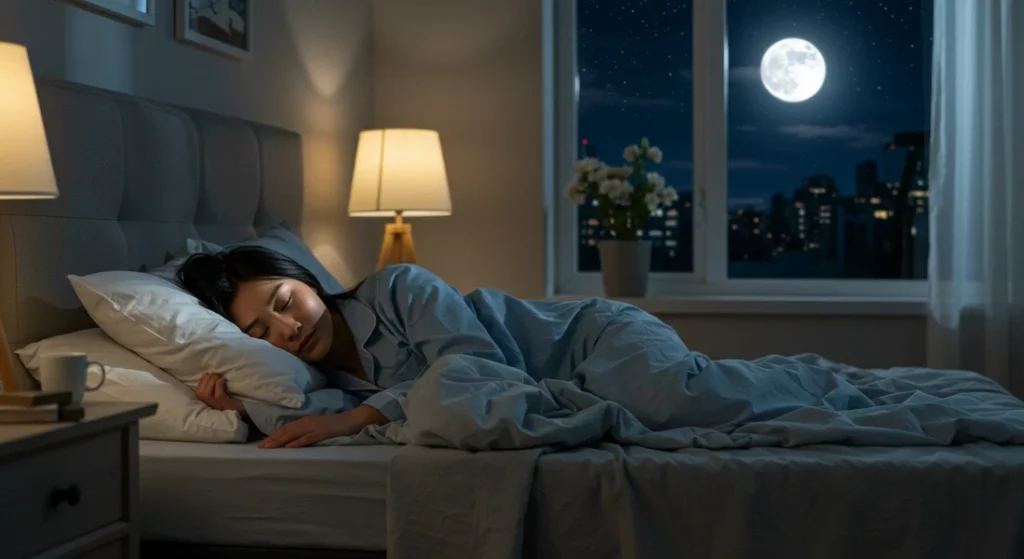Tired of counting sheep?
If you’re one of the millions struggling to get a good night’s rest, you know how frustrating and debilitating sleeplessness can be.
That’s why Deep Breathing for Sleep is becoming a go-to solution for people, who want to rest peacefully and wake up in high spirits.

Quality sleep is essential.
It fuels our bodies, minds, and overall well-being.
But for too many of us, stress and anxiety create a vicious cycle of sleepless nights.
The pressure to perform, racing thoughts, and the constant stimulation of our modern world can all disrupt our natural sleep patterns.
But what if there was a simple, drug-free way to break free from this cycle and reclaim your rest?
Deep breathing techniques work like a charm and you will reap a ton of benefits from doing it, by working with your body’s natural relaxation response to soothe your mind, calm your nervous system, and prepare you for a night of restful, restorative sleep.
In this ultimate guide, you’ll discover the science-backed power of deep breathing and learn practical techniques you can use tonight to transform your sleep.
Key Takeaway
Deep breathing is a natural and effective way to improve your sleep and wake up feeling refreshed.
The Science of Deep Breathing and Sleep

It’s not just about feeling sleepy.
You might not feel sleepy but it doesn’t mean your mind doesn’t need rest!
But you can see from here that the science is very compelling to you!
Deep breathing triggers a series of physiological changes that prepare your body and mind for sleep.
The parasympathetic nervous system (PNS) and relaxation response
Your autonomic nervous system, which controls involuntary functions such as breathing, has two main branches.
One is the sympathetic, “fight or flight”, and the other is the parasympathetic, which is the rest and digest.
Slow breathing techniques are known to activate the PNS, which results in a calm and relaxed body.
Heart rate variability (HRV) and stress reduction
Your Heart rate variability tracks the time frames between heartbeats.
If you have a higher HRV, you are known to be more stress resistance.
Deep breathing techniques, such as meditation and box breathing, have been known to improve the HRV.
Melatonin production and sleep regulation
Melatonin is a hormone that regulates sleep and wakefulness.
Your production of melatonin is often disrupted by irregular sleeping patterns, and or stress.
Deep breathing has been shown to increase the production of melatonin.
Brainwave activity and sleep stages
Each breathing technique stimulates different types of brainwave.
With deep breathing, there are alpha and theta waves, which are associated with sleep.
If there is a stimulation of these brainwaves, it allows for people to transition to sleep.
Deep Breathing allows you to experience peace, calm, and better control of the body. What more can you ask for?
If you found this interesting and compelling, you should continue reading for the step by step.
Ready?
Deep Breathing Techniques for Better Sleep
Now that you have understood the science, you are likely very excited to find out how to apply it!
Here is how you perform the different types of breathing exercises that lead to sleep!
Diaphragmatic Breathing (Belly Breathing)

- Description: Improve relaxation before you go to bed.
- Steps:
- Lie on your back and bend your knees!
- Put one hand on your belly, and put the other on your chest.
- Breath with your belly and try not to move your chestBenefit: Reduce restlessness and improve relaxation
- Timing: Before you go to bed.
- Variations: Seated, lying down, with guided meditation.
4-7-8 Breathing

- Description: Promotes rest and sleep.
- Steps:
- With your tongue on the upper front teeth.
- Exhale fully.
- Inhale, and hold your breath for 7.
- Exhale through your mouth, slowly.Benefit: Promotes quality sleep.
- Timing: At bed.
- Variations: With added focus, imagine you are laying somewhere relaxing.
Box Breathing
- Description: Calming Nervous system.
- Steps:
- Exhale fully.
- Breath and hold the air and hold for 4 second.
- Breath out and hold for 4 second.
- Repeat
- Benefit: Calming you so you can sleep
- Timing: For 15 minutes before bed
- Variations: Add duration and hold longer.
Alternate Nostril Breathing
- Description: Improves the balance
- Steps:
- With your hand, block one nostril with your fingers.
- Slowly breath in and breath out.
- Repeat
- Benefit: Improves sleep, but not before bed.
Timing: Not recommended before bed.
Variations: Add time as you improve.
PMR (Progressive Muscle Relaxation)
- Description: Reduce muscle tension before you sleep.
- Steps: Breath then tense your muscles with your body parts
- Exhale and feel your body as you do with each body part.
- Focus and feel you are trying to relax different areas.Benefit: Calm you and help you sleep.
- Timing: A few hours before.
- Variations: Practice it often and test yourself.
Choosing the Right Technique for You
With so many breathing techniques to choose from, how do you decide which one is right for you?
Here’s a quick guide to help you find the perfect fit:
| Technique | Primary Benefits | Best Time to Practice | Difficulty | Key Cue |
| Diaphragmatic Breathing | Reduces anxiety, promotes relaxation, eases into sleep | Before Bed, anytime you feel tense | Easy | Focus on expanding your belly with each inhale |
| 4-7-8 Breathing | Promotes faster sleep onset, calms the mind | Right Before Bed | Easy | Remember the count: 4-Inhale, 7-Hold, 8-Exhale |
| Alternate Nostril Breathing | Balances energy, reduces stress | Anytime During the Day (not right before bed) | Medium | Alternate closing nostrils as you breathe |
| PMR (Breath Integrated) | Relieves muscle tension, promotes deep relaxation | A Few Hours Before Bed | Easy | Tense then release each muscle group as you breathe deeply |
Disclaimer: The information provided in this blog is for educational purposes only. Consult with a healthcare professional before making any changes to your health regimen.
Creating A Better Breathing Routine
Now that you know the techniques, here’s how to weave them into your nightly routine for better sleep.
Set the Mood – Creating a Relaxing Sleep Environment
Your bedroom should be a sanctuary for sleep.
Here’s how to set the stage:
- Dim the Lights: Use blackout curtains, dimmers, or a salt lamp to minimize light exposure.
- Keep it Cool: A slightly cooler temperature (around 65 degrees Fahrenheit) is ideal for sleep.
- Reduce Noise: Use earplugs, a white noise machine, or a fan to block out distracting sounds.
- Aromatherapy (Optional): Add a few drops of lavender or chamomile essential oil to a diffuser.
Combine Breathing with Other Sleep Hygiene Practices

For best results, integrate deep breathing with other healthy sleep habits:
- Maintain a Regular Sleep Schedule: Go to bed and wake up around the same time each day, even on weekends.
- Create a Relaxing Bedtime Routine: Wind down with a warm bath, reading, or gentle stretching.
- Avoid Caffeine and Alcohol Before Bed: These substances can interfere with your sleep.
- Limit Screen Time: The blue light emitted from screens can suppress melatonin production. Aim to disconnect from devices at least an hour before bed.
Troubleshooting Common Problems
It’s not always smooth sailing. Here’s how to address common challenges:
- Racing Thoughts: If your mind is racing, try journaling before bed to clear your head. You can also try a guided meditation specifically designed for sleep.
- Difficulty Focusing: If you find it hard to focus on your breath, start with shorter sessions (e.g., 5 minutes) and gradually increase the duration.
- Feeling Restless: If you feel restless, try a different breathing technique or combine deep breathing with gentle stretching.
Sample Bedtime Breathing Schedule
Here’s an example to help you get started:
- 9:00 PM: Start winding down with a warm bath or reading.
- 9:30 PM: Dim the lights and turn on a white noise machine.
- 9:45 PM: Lie down in bed and practice diaphragmatic breathing for 10 minutes.
- 10:00 PM: Practice 4-7-8 breathing for 5 minutes to drift off to sleep.
Remember: Consistency is key! Stick with your routine as much
When to Seek Professional Help
Deep breathing techniques can be a valuable tool for improving sleep, but they’re not a magic bullet.
If you’ve been consistently practicing deep breathing for several weeks and are still struggling with significant sleep problems, it’s important to seek professional help.
Here are some signs that you may need to consult a doctor or sleep specialist:
- Persistent Insomnia: If you consistently have trouble falling asleep, staying asleep, or waking up too early, despite practicing good sleep hygiene and deep breathing techniques.
- Excessive Daytime Sleepiness: If you feel excessively tired or sleepy during the day, even after getting what you think is enough sleep at night.
- Snoring, Gasping, or Pauses in Breathing During Sleep: These could be signs of sleep apnea, a serious sleep disorder that requires medical attention.
- Difficulty Functioning Due to Lack of Sleep: If your sleep problems are significantly impacting your daily life, including your work, relationships, or ability to concentrate.
- Underlying Medical Conditions: Certain medical conditions, such as anxiety disorders, depression, chronic pain, or thyroid problems, can interfere with sleep. If you have any of these conditions, it’s important to work with your doctor to manage them effectively.
The Role of Therapy and Medication:
A doctor may also find that you need therapy. Here are some recommendations
- CBT
- Stress and Anxiety Therapy
- Medication
- And other suggestions as needed.
Disclaimer: This information is not a substitute for professional help, and the decision is always yours!
Resources and Tools
Here are few resources that can be helpful to you:
Guided Mediation: You are able to have a voice that tell you what to do and is useful to help you focus.
Sleep Tracking: If you aren’t sure how to use the breathing, sleep tracking is very useful to finding what is good and bad.
Aromatherapy Diffusers: If you have anxiety and or other things that you like, this will further assist in having those nice good feelings!
These resources will all further assist your well-being for a low cost! (Note: Affiliate Links)
Frequently Asked Questions – Your Sleep Questions Answered!
Still have questions about deep breathing and sleep?
Here are 5 common questions and their answers.
- I’ve tried everything and it doesn’t work, what now?
- Keep at it! Persistence is key. If you’re still struggling, it’s worth checking with a doctor to rule out any underlying medical conditions affecting your sleep.
- I just can’t fall asleep, what do I do?
- It’s important to understand why you can’t sleep. Are you dealing with stress, anxiety, or other issues? Seeking help from a therapist or sleep specialist can help you get to the root cause and find solutions.
- I’ve been doing it for one day and it doesn’t work.
- Rome wasn’t built in a day, and neither is a perfect sleep routine! It takes time and consistent effort to see results. Stick with it, be patient, and remember that small improvements add up over time.
- What if I can’t clear my mind before bed?
- It’s okay for it to race or be difficult to fully clear your mind! Try focusing on your breathing for a few breaths.
- How long do I need to do the exercises for them to work?
- Do breathing exercises until you feel calm, and try to make the a part of you.
Conclusion – Unlock Restful Nights & Energized Mornings with Deep Breathing
Ready to transform your sleep?
You now have the tools to:
- Fall Asleep Faster: Say goodbye to endless tossing and turning.
- Improve Sleep Quality: Wake up feeling refreshed and revitalized.
- Reduce Stress & Anxiety: Calm your mind and relax your body.
- Unlock Your Best Sleep Ever: Deep breathing puts you in control!
- Ready to experience the difference?
Download your FREE “Sleep Well Tonight” cheat sheet and start breathing your way to better sleep tonight!
It’s time to become the alpha of your sleep!
References
- On Diaphragmatic Breathing and Sleep Quality:
- Eman Fadl. Abd El Khalik, Marwa Mohammad, Marwa M. Abd Elbaky (2020). The Effectiveness of Using Breathing Exercise on Sleep Quality Among Hospitalized Patients
- On 4-7-8 Breathing and Anxiety Reduction:
- Gülfidan Kurt Aktaş, Vesile Eskici İlgin. (2022). The Effect of Deep Breathing Exercise and 4-7-8 Breathing Techniques Applied to Patients After Bariatric Surgery on Anxiety and Quality of Life
- On Box Breathing and Stress Response:
- American Lung Association (2024). Simple Breathing Exercises to Help You Manage Stress
- On Melatonin and Breathing Techniques:
- Ravinder Jerath , Connor Beveridge, Vernon A Barnes. (2019). Self-Regulation of Breathing as an Adjunctive Treatment of Insomnia
- On Heart Rate Variability and Sleep:
- Amirreza Sajjadieh, Ali Shahsavari, Ali Safaei . (2020). The Association of Sleep Duration and Quality with Heart Rate Variability and Blood Pressure
- Amirreza Sajjadieh, Ali Shahsavari, Ali Safaei . (2020). The Association of Sleep Duration and Quality with Heart Rate Variability and Blood Pressure
Related Posts
No posts
